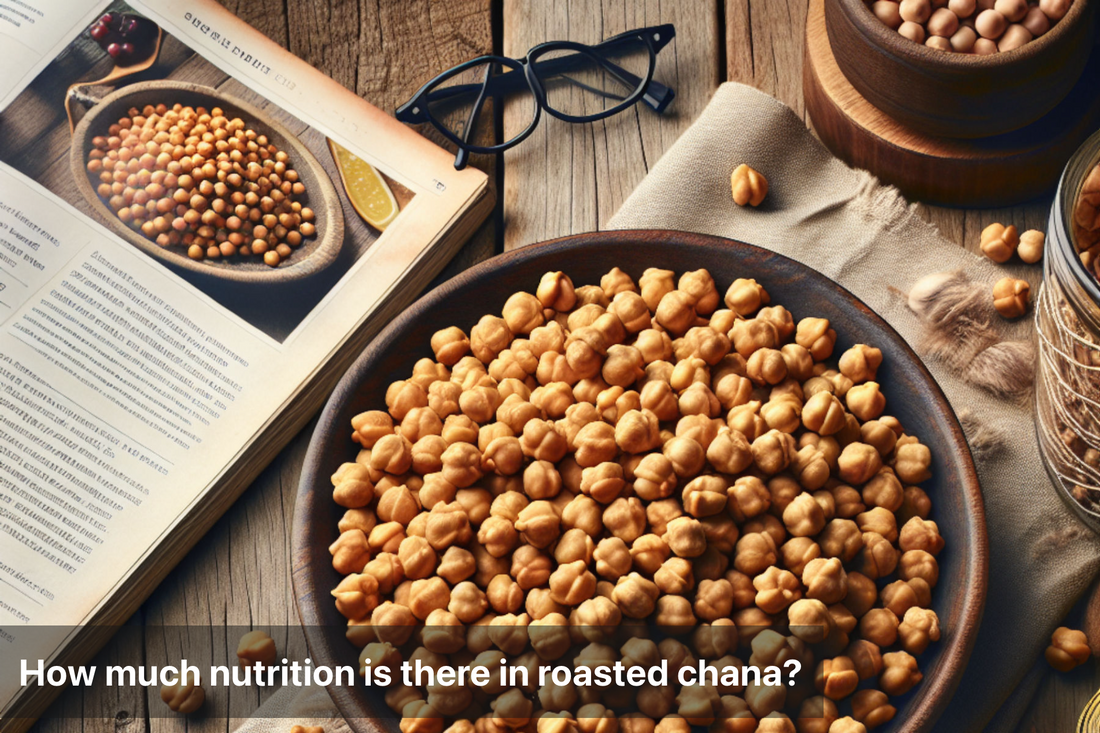
How much nutrition is there in roasted chana?
Share
Roasted chana, or roasted chickpeas, is one of the most underrated yet highly nutritious snacks widely consumed across India. Affordable, shelf-stable, and protein-packed, roasted chana is not just a crunchy, guilt-free snack—it’s a nutritional powerhouse that fits into most diets, from weight-loss plans to diabetic-friendly routines
But exactly how nutritious is roasted chana? What are the macro and micronutrients it offers, and how does it support your health goals? This blog dives deep into the nutrition profile, health benefits, comparisons with other snacks, and smart ways to add roasted chana to your daily diet
What Is Roasted Chana?
Roasted chana, also known as roasted Bengal gram, is made by roasting desi (small, dark-skinned) chickpeas until they become crispy and easy to chew. It can be consumed with or without the outer skin (bhuna chana or chana dal form). Often eaten plain or lightly salted, roasted chana is commonly found in Indian kitchens and sold in grocery stores as a ready-to-eat snack
Nutrition in 100g Roasted Chana
Here is a breakdown of the approximate nutritional content in 100 grams of roasted chana:
Nutrient |
Amount (per 100g) |
|---|---|
Energy |
370–385 kcal |
Protein |
18–20g |
Carbohydrates |
60–65g |
Fiber |
12–15g |
Fat |
4–5g |
Sugar |
<2g |
Iron |
4–5 mg |
Calcium |
45–60 mg |
Magnesium |
120–130 mg |
Potassium |
800–900 mg |
Sodium |
5–8 mg (unsalted) |
Note: These values can slightly vary depending on whether the chana is skinless, salted, or dry-roasted with oil
Macronutrient Benefits of Roasted Chana
High Protein Content
Offers 18–20g of plant-based protein per 100g
Excellent for vegetarians aiming to meet daily protein needs
Supports muscle repair, satiety, and overall metabolic function
Complex Carbohydrates
Contains slow-digesting carbs that provide sustained energy
Helps manage hunger without blood sugar spikes
High Fiber
12–15g of dietary fiber promotes digestive health
Supports bowel regularity, gut microbiome, and fullness
Low in Fat and Sugar
Naturally low in sugar and free from trans fats
Suitable for low-fat diets and diabetes management
Micronutrients in Roasted Chana
Iron: Helps in red blood cell production and combats fatigue
Magnesium: Important for nerve function, bone health, and blood pressure regulation
Potassium: Balances sodium levels and supports heart health
Calcium: Maintains bone density and muscle function
Folate and B-vitamins: Aid in energy production and cell function
Health Benefits of Roasted Chana
Supports Weight Management
High in protein and fiber, keeping you full for longer
Makes a low-calorie snack option compared to chips or sweets
Helps reduce unnecessary snacking between meals
Aids in Blood Sugar Control
Low glycemic index helps prevent sugar spikes
Ideal for diabetics when consumed unsweetened and unflavored
Promotes Heart Health
Contains no cholesterol and is low in saturated fat
Magnesium and potassium help regulate blood pressure
Improves Digestive Health
Dietary fiber promotes regular bowel movements and healthy gut flora
Reduces chances of constipation and bloating
Energy Boosting
High in iron and complex carbs, roasted chana can combat fatigue and enhance stamina
Good snack option for students, professionals, and athletes alike
Roasted Chana vs. Other Indian Snacks
Snack |
Calories (Per 100g) |
Protein |
Fat |
Sugar |
Fiber |
|---|---|---|---|---|---|
Roasted Chana |
370–385 |
18–20g |
4–5g |
<2g |
12–15g |
Potato Chips |
520–550 |
6–7g |
35–38g |
1–2g |
2–3g |
Fried Namkeen Mixture |
500–520 |
8–10g |
30–35g |
4–6g |
3–4g |
Salted Peanuts |
560–600 |
25g |
45–50g |
3–5g |
8g |
Masala Makhana |
400 |
12–14g |
20g |
1g |
10g |
Roasted chana offers a far better protein-to-fat ratio than most fried snacks, making it one of the healthiest Indian nibbles available
How to Include Roasted Chana in Your Diet
Mid-morning or evening snack: A handful (30g) provides ~6g of protein and ~100 kcal
Post-workout bite: Pair with a boiled egg or fruit for a protein-carb combo
Add to chaats or salads: Use in mixed sprouts, cucumber salads, or puffed rice mixtures
With jaggery: Combine with a small piece of jaggery (gur) for a traditional energy booster
Roasted chana flour (sattu): Used in drinks or parathas for added nutrition
Ideal Serving Size
25–30g per day is a moderate and effective portion
This gives ~100–120 kcal, 5–6g protein, and 3–4g fiber
Perfect for weight watchers, diabetics, and fitness-focused individuals
Is Roasted Chana Suitable for Everyone?
Yes, generally safe for most people, including kids and the elderly
Those with legume allergies or digestive sensitivity (like IBS) may need to moderate intake
For high blood pressure patients, choose unsalted versions
Diabetics should avoid versions coated in sugar or honey
Tips to Choose the Healthiest Roasted Chana
Look for unsalted and oil-free versions in stores
Avoid sweet-coated, masala-laden, or fried versions that contain additives
Store in airtight jars to maintain crispness and prevent rancidity
Check labels if buying packed varieties for added oils or preservatives
Conclusion
Roasted chana is a nutritional gem—low in fat, high in protein, rich in fiber, and naturally gluten-free. With around 370–385 calories and 18–20g of protein per 100g, it stands out as one of the healthiest, most accessible snacks in Indian diets
Whether you're trying to lose weight, manage blood sugar, or simply snack smarter, roasted chana is a crunchy companion worth including in your daily routine. It proves that healthy eating doesn’t have to be boring—or expensive






